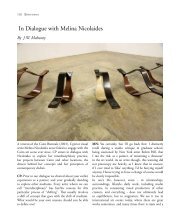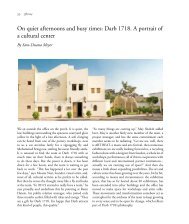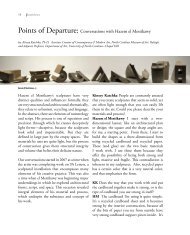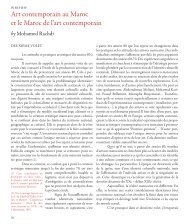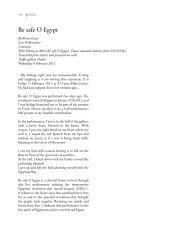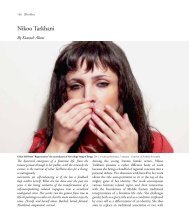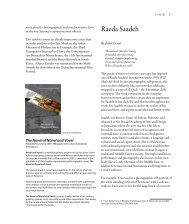abu dhabi international sculpture symposium 2010 - Contemporary ...
abu dhabi international sculpture symposium 2010 - Contemporary ...
abu dhabi international sculpture symposium 2010 - Contemporary ...
Create successful ePaper yourself
Turn your PDF publications into a flip-book with our unique Google optimized e-Paper software.
104 Reviews<br />
ABU DHABI INTERNATIONAL<br />
SCULPTURE SYMPOSIUM <strong>2010</strong><br />
by Professor Billy Lee<br />
The first Abu Dhabi International Sculpture<br />
Symposium (ADISS) took place recently in the<br />
capital of the United Arab Emirates. The timing<br />
could not have been better as the city is in the<br />
middle of promoting the largest concentration of<br />
premier buildings by world renowned architects<br />
in the cultural district of Saadiyat Island. The<br />
district’s main institutions will be: Zayed<br />
National Museum by Sir Norman Foster, Louvre<br />
Abu Dhabi by Jean Nouvel, Guggenheim Abu<br />
Dhabi by Frank Gehry, Performing Arts Centre<br />
by Zaha Hadid and the Maritime Museum by<br />
Tadao Ando. Following the tradition of fine art,<br />
architecture and <strong>sculpture</strong> have always had a<br />
strong symbiotic relationship. It is fitting that<br />
these <strong>sculpture</strong>s be introduced as Abu Dhabi<br />
enters the <strong>international</strong> cultural scene. These<br />
monumental <strong>sculpture</strong>s under the theme of<br />
“Bridging Societies Through the Language of<br />
Art” are the initiative of His Highness Sheikh<br />
Mohammad Bin Zayed, Crown Prince of Abu<br />
Dhabi and Deputy Commander of the Armed<br />
Forces as part of his 2030 vision to establish Abu<br />
Dhabi as the cultural centre for the region.<br />
The ADISS event is under the patronage of His<br />
Highness Sheikh Mohammad Bin Zayed and<br />
under the guidance of His Excellency Sheikh<br />
Nahyan Mabarak Al Nahayan, Minister of<br />
Higher Education and Scientific Research. It<br />
was organized by Zayed University, a globally<br />
Konstantin Dimopoulos (Australia)_SINUOUS RED
Reviews<br />
105<br />
accredited university, in collaboration with<br />
the Salwa Zeidan Gallery, one of the most<br />
prominent art galleries in the country, with<br />
strategic partners such as the Municipality<br />
of Abu Dhabi and the Armed Forces Officers<br />
Club. This is the first collection of public art<br />
in Abu Dhabi and will be installed along the<br />
fashionable walkway of the Corniche for a year<br />
before being permanently placed throughout<br />
various parts of the city.<br />
Over 450 proposals were submitted from<br />
around the world out of which only seventeen<br />
were accepted. Each of the selected artists was<br />
asked to submit several design options for final<br />
selection by the organizing committee. Salwa<br />
Zeidan, herself an artist, was responsible for<br />
selecting and curating the <strong>symposium</strong> and<br />
felt “it was imperative that we find renowned<br />
and experienced artists who could not only<br />
elevate the standard of the event, but also add<br />
value to the lecture programme and in turn,<br />
enrich interaction with the public and [Zayed<br />
University] students.” According to Salwa,<br />
this project took over two years in the making<br />
before coming to fruition. Her keen perception,<br />
determination and vision made this <strong>symposium</strong><br />
enormously successful in introducing public art<br />
to the city. It is a difficult task to put together<br />
a collection of contemporary <strong>sculpture</strong>s, given<br />
the pluralistic condition of art in general. This<br />
has been particularly true in the last few decades<br />
where boundaries in art have been blurred and<br />
it would seem that anything short of being<br />
nailed to a wall is now considered <strong>sculpture</strong>. The<br />
success of Salwa’s initiative, insight, persistence<br />
and passion for art are certainly reflected in the<br />
outcome of this <strong>symposium</strong>. The sculptors she<br />
selected are diverse, but have still maintained<br />
the fundamental tenets of sculptural language.<br />
In 1957, Karl Prantl, an Austrian stone sculptor,<br />
established the first of the <strong>sculpture</strong> symposia<br />
in an abandoned stone quarry in order to<br />
encourage networking and collaboration<br />
amongst <strong>international</strong> sculptors. It was this<br />
basic premise of inviting sculptors from around<br />
the world to meet in one location in order to<br />
work together and discuss and exchange ideas,<br />
which created a strong network of sculptors<br />
leading to the numerous symposia held<br />
around the world today. In general, symposia<br />
stone sculptors have developed a strong set<br />
of skills in crafting stone and working with<br />
traditional concepts of <strong>sculpture</strong>. Following in<br />
that strong tradition of master stone carvers<br />
are works by Joni Gogaberishvili (Republic of<br />
Georgia), Jo Kley (Germany), Fabrizio Dieci<br />
(Italy), Caroline Ramersdorfer (Austria), and<br />
emerging artist Husam Chaya (Lebanon). It is<br />
refreshing to see the exquisite execution of a<br />
traditional process, which was once the training<br />
for young sculptors. In the United States and<br />
United Kingdom the practice of stone carving<br />
as the primary medium for sculptors has long<br />
been defunct. It has been eradicated from the<br />
curriculum of art schools as a basis for training<br />
sculptors. Since the 1960s, art in general, and<br />
particularly public art, has evolved beyond these<br />
traditional concepts. The 1970s and 1980s<br />
paved the way for a large number of diverse<br />
artists to move out of the studio and interact<br />
directly with the environment and an audience<br />
in the public arena. Engagement in social and<br />
community collaboration became prevalent and<br />
evolved during the 1990s where multimedia<br />
and technology added to the reshaping of public<br />
art and blurred the boundaries of <strong>sculpture</strong> even<br />
further.<br />
Although the event in Abu Dhabi was called a<br />
<strong>symposium</strong>, its goal and concept deviated from<br />
the norm in that the makeup and selection of<br />
artists was contemporary in its thinking, while
106 Reviews<br />
still maintaining the notions of sculptural<br />
language. Salwa Zeidan sought to combine the<br />
sculptural attitudes of traditional stone carving<br />
with that of contemporary critical inquiry.<br />
There were seven sculptors who were not stone<br />
carvers, of which six worked in steel and the<br />
other, a kinetic sculptor, using carbon fibre<br />
rods. This combination created a catalyst for an<br />
interesting and diverse collection of sculptors and<br />
viewpoints. Each sculptor was asked to produce<br />
a durable <strong>sculpture</strong> which would address public<br />
spaces in Abu Dhabi in concept, stature and<br />
scale. Egyptian artist, Ehab El Labban, carved<br />
a powerful six-metre high vertical black marble<br />
monolith entitled Highness. As the title implies,<br />
the <strong>sculpture</strong> stands aloof in its position,<br />
pondering its surroundings and the horizon.<br />
It has a strong sense of place and presence,<br />
allowing layers of past and present to surface<br />
as it is rooted in the ground. The simplicity of<br />
the vertical form suggests an anthropomorphic<br />
presence, but is minimalist and contemporary in<br />
approach. It alludes to the notion of questioning<br />
identity, context and place.<br />
Water Mark, by Yoshin Ogata from Japan, has<br />
a simple and minimal approach to stone, but<br />
the results are grand in stature. His thinking<br />
is characteristically Japanese with regard to the<br />
idea that less is more. With a few ripples on a<br />
six-metre high piece of marble, he transcends<br />
the stone into a monumental experience of<br />
nature, not dissimilar in concept to the Japanese<br />
tradition of the Ryōan-ji dry gardens in Kyoto.<br />
Like El Labban, Ogata has managed to maintain<br />
his identity and sense of self with a contemporary<br />
awareness.<br />
Gheorghi Filin’s Sailing in the Desert is as poetic<br />
as the title suggests. The vertical white sail, which<br />
breaks the horizon, is a metaphor for travelling<br />
in one’s own mind to an ethereal magical place.<br />
As a single object in space, the engagement of<br />
spatial interaction works well in both a macro<br />
as well as micro way. From a distance it is what<br />
it appears to be, a single sail in the vastness<br />
of the desert, a mirage of illusion, but upon<br />
closer scrutiny the transition of scale is human<br />
and thus engages an intimate experience. One<br />
is easily seduced by the sensual tactility of the<br />
ridge marks and holes. The idea of addressing<br />
scale in <strong>sculpture</strong> is evident in Petre Petrov’s<br />
Spirit: two very simple forms, stacked one<br />
upon the other, standing in a traditional stance<br />
of monumentality. When one approaches and<br />
stands directly underneath this four-metre high<br />
stone <strong>sculpture</strong>, one finds oneself engaged on<br />
an intimate and personal level of being inside,<br />
Ehab El Laban, (semow)
Reviews<br />
107<br />
which is a very different sensation from that<br />
experienced at distance. The interior void has a<br />
wonderful surprise of light and a sense of comfort<br />
which engages the viewer on an intimate level<br />
and yet at the same time is inaccessible. The idea<br />
of accessibility and interaction is what Masahiro<br />
Hasegawa’s Lotus is about. It is an invitation to<br />
walk through and under nine elegant stainless<br />
steel lotus pads ranging from one metre to<br />
nine metres. The lotus pads are laid out in a<br />
meticulous and precise arrangement as in most<br />
traditional Japanese gardens. At the same time,<br />
Lotus has an imaginative playfulness about it.<br />
It has a contemporary “Alice in Wonderland”<br />
adventurousness, especially with the placement<br />
of a number of crystal clear glass drops on the<br />
rims of the pads. One cannot help but think<br />
that there is a playful side to what may at first<br />
seem traditional.<br />
Spanish artist Juanjo Novella eloquently<br />
suggests interaction and engagement on both<br />
the physical and conceptual levels in Durango,<br />
which has many layers to unravel. The paradox<br />
Novella creates raises interesting issues regarding<br />
our urban environment. The <strong>sculpture</strong> stands<br />
by itself and yet its presence is defined by its<br />
environment. The one-inch thick plate is a<br />
modern industrial material, and yet in his hands,<br />
it is transformed into something as delicate,<br />
vulnerable and intricate as might be found in<br />
nature’s living and breathing surroundings. The<br />
environment and structure are synonymous<br />
in that one cannot see and experience one<br />
without being aware of the other. The scale is<br />
monumental while its seductive accessibility<br />
allows for an engagement of intimacy.<br />
At first glance, Herald , by Korean artist Seung-<br />
Woo Hwang, seems to merely mimic a stack<br />
of books, but upon closer examination one<br />
Gheorgi Filin (Bulgaria)_SAILING IN THE DESERT<br />
experiences a hint of an underlying suggestion<br />
of the intentional monotony of our daily<br />
preoccupations. The careful monotonous<br />
repetition of cutting what might be endless<br />
edges of the pages of books cannot help but<br />
make us think about the value or point of daily<br />
rituals and their repetition. It poses questions<br />
about our daily engagement with paper on all<br />
levels. Hwang’s <strong>sculpture</strong> is deceptive, as what<br />
may appear to be obvious is indeed exactly<br />
what he is pointing out and thus, he questions<br />
its validity. This is an interesting way of dealing<br />
with abstract ethereal concepts through a solid<br />
traditional monolithic material such as stone.<br />
Elusive Cycles , by Billy Lee, is a striking fivemetre<br />
polished stainless steel <strong>sculpture</strong> and<br />
is the only piece that has directly engaged the
108 Reviews<br />
context of the Middle East by its employment of<br />
letters of the Arabic alphabet. The form, which<br />
is simple and minimal, changes and evolves<br />
continually, much as the title implies. What<br />
may seem simple at first, engages the viewer in<br />
what alludes to a complex gestalt. The mirror<br />
finish surface between the calligraphy reflects<br />
the environment as well as the letters on a<br />
perpendicular plane, fusing reality with illusion.<br />
What is interesting is that there is a “place”<br />
which one is not fully aware of as one negotiates<br />
reading between a flat plane and moving in a<br />
three dimensional space, that “place” between<br />
two and three dimensions.<br />
Sinuous Red, by Konstantin Dimopoulos, is a<br />
six-metre high kinetic <strong>sculpture</strong> made of carbon<br />
fibre composite rods that are activated by the<br />
wind. The beauty of Dimopoulos’ concept is that<br />
he allows nature to be part of his piece and does<br />
not fight or attempt to control it. His <strong>sculpture</strong><br />
is the conduit through which nature acts to<br />
create its own symphony. It sways, vibrates and<br />
oscillates like a series of line drawings in space.<br />
It recalls a childlike fascination of anticipating<br />
what will happen next.<br />
Slovenian artist Gregor Kregar’s stainless steel<br />
<strong>sculpture</strong>, Twisting the Void, is made up of<br />
428 equilateral triangles forming multiple<br />
modules assembled in a biomorphic cloud<br />
like formation. The form is monolithic and<br />
massive and yet at the same time is transparent<br />
and elusive. Kregar points out the beauty of<br />
mathematics and systems in nature and their<br />
relativity to the urban environment. The mirrorpolished<br />
surface fragments the reflection of the<br />
surrounding environment, not only assuming<br />
its appearance but also fracturing and changing<br />
it, thus questioning whether things are really<br />
what they appear to be. As can be the case when<br />
Salwa Zeidan - Lebanon_ADISS FLOWER_Size 165 cm x 215 cm Height<br />
observing nature, what may be seemingly within<br />
one’s grasp becomes illusive. Jon Barlow Hudson<br />
from the United States and renowned Dubai<br />
artist Hassan Sharif both have large, six-metre<br />
high linear steel <strong>sculpture</strong>s soaring in space and<br />
looming over the viewer. Jon Barlow Hudson’s<br />
simple linear form, Eidolon Elliptical Sphere,<br />
activates the negative space as it encompasses it,<br />
making us very much aware of the void between.<br />
The simplicity of Step <strong>2010</strong>, by Hassan Sharif,<br />
is as precise as the clarity of his thinking. Its<br />
fluidity and gesture of the stance is typical of his<br />
prolific career as an artist in Dubai.<br />
The artists in this <strong>symposium</strong> have provided<br />
us with probing and revealing ideas of their<br />
human experience. Rather than attempting to<br />
provide us with answers, they have set out to<br />
raise questions. It is interesting that these artists<br />
have a sense of place and identity, which has<br />
been displaced in much of contemporary art<br />
as globalization becomes prevalent. The danger
Reviews<br />
109<br />
of a rapid premature growth in the guise of<br />
advancement is the risk of homogeneity and the<br />
loss of that self and identity. A great deal of work<br />
around the world does not seem to be rooted in<br />
place or identity, but rather seems to look much<br />
the same. As our lifestyles and environment<br />
become more transient and similar despite<br />
our cultural and geographical differences, it is<br />
important that we maintain our individuality,<br />
identity and sense of place.<br />
Billy Lee was born of Chinese and<br />
Dutch parentage in Uitenhage,<br />
South Africa. As a child, his parents<br />
immigrated to England, where he<br />
later received his BFA, 1st class<br />
honours, from Birmingham College<br />
of Art and Design, and his MFA at<br />
the Royal College of Art, London<br />
(RCA). Upon graduation from the<br />
RCA, he received the prestigious<br />
award of Kennedy Scholar, to attend<br />
the Centre for Advanced Visual<br />
Studies at Massachusetts Institute<br />
of Technology (MIT) and was later<br />
named a Fellow.<br />
Thanks to the considerable and<br />
growing <strong>international</strong> reputation,<br />
Lee is consistently invited to exhibit<br />
and place works throughout the<br />
world. His <strong>sculpture</strong>s are represented<br />
in public collections across the<br />
globe, including Yuzi Paradise<br />
Sculpture Park, Guilin, China, The<br />
Hakone/Utsukushi-ga-hara Open<br />
Air Museum, Japan, Goodwood<br />
Sculpture, UK, The Memorial Rose<br />
Garden, Chin Pao San, Taipei,<br />
Taiwan, Dunaujvaros Sculpture<br />
Park, Hungary, Cementerio<br />
Carretas, Putaendo Sculpture Park,<br />
Chile, Abu Dhabi, UAE, and many<br />
others in the United States.<br />
Recently, he has been working<br />
in China creating large outdoor<br />
<strong>sculpture</strong>s. In addition, he continues<br />
to exhibit in the USA, UK, Europe<br />
and the Far and Middle East. Lee<br />
currently resides in the United States<br />
and is a professor at the University<br />
of North Carolina at Greensboro.<br />
Yoshin Ogata - (Japan)_WATER MARK



